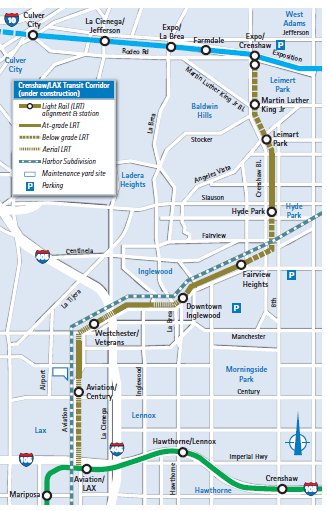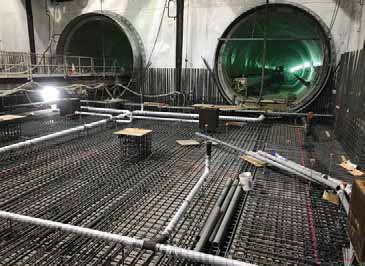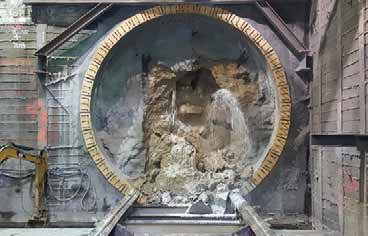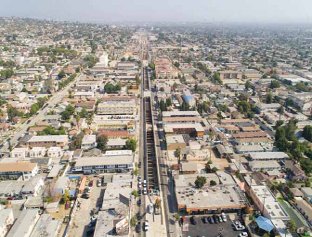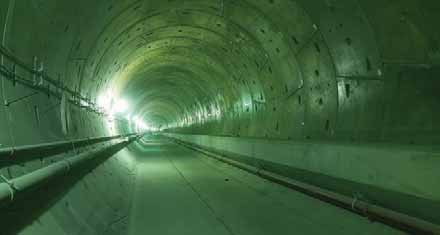Good neighbour
24 May 2018Paola De Pascali spoke with Walsh/Shea Corridor Constructors about the challenges of the Metro Crenshaw/LAX Line in Los Angeles
Working in a dense urban environment is always challenging. When a metro line needs to cross a big city like Los Angeles in close proximity to a major airport, logistics becomes one of the main priorities. This is a key task for the contractor, Walsh/Shea Corridor Constructors (WSCC) as it works to construct the Metro Crenshaw/LAX Line, which will extend from the existing Metro Exposition Line at Crenshaw and Exposition Boulevards. The Line will travel 8.5 miles (13.7km) and connect to the Metro Green Line and will serve the cities of Los Angeles, Inglewood and El Segundo; and portions of unincorporated Los Angeles County. The new line will offer an alternative transportation option to congested roadways and provide significant environmental benefits, economic development and employment opportunities throughout Los Angeles County.
The line includes the construction of eight stations: three at-grade, one elevated, and three underground. Twin tunnels run for approximately 10,500ft (3.2km) and have five cross passages. There is a cut and cover tunnel of 3,500ft (1km) and a partially covered trench of 1,500ft (457m).
The value of this contract is USD 1.27bn. The project started in 2013 and it should be completed in October 2019. Some key milestones include the demolition and site preparatory work ahead of excavation from 2014 to 2016; invert slab installation from 2015 to 2016; and TBM assembly and mining from 2015 to breakthrough last year. This spring the contractor is focused on completing the structural concrete work on the project and installation of the track and systems. This includes the three underground station structures, where the roofs and walls are being constructed and work is being turned over to the finishing subcontractors, which covers masonry, acoustical, Mechanical/Electrical/Plumbing and structural steel work.
The contractor will complete a major portion of tying the line into the existing rail system at the Green Line. Additional track work will continue through the spring and includes at-grade crossings, ballasted and direct fixation track work.
The systems team will be focused on communications, overhead catenary, train control, and traction power installation and testing.
CHALLENGES
Carl Christensen, Walsh/Shea Corridor Constructors, construction manager explains they faced a lot of challenges in this busy urban area, such as traffic control, pedestrians, and closing a major roadway. “When it was necessary to work at night, we used sound blankets to mitigate the noise equipment,” says Christensen. “Work at night has been on-going for over four years.
“This project includes bridges, underground stations, egress sections, and other types of constructions; therefore, we have several specialists advising on the health and safety aspects of the project.” The line is being built in the middle of Crenshaw Boulevard. Christensen says they used an innovative engineering approach for the construction of this structure.
“A cantilevered decking system was constructed by implementing a temporary support of excavation design which allowed staged top-down excavation while maintaining traffic flow during construction,” he explains. “The cast-inplace structure was built utilising two 50ft- (15m-) long Efco traveller forms, fabricated specifically for this project, improving the cycle time of the concrete construction.
“Another logistical challenge that was very tough was removing muck from the bored tunnel excavation. The use of admixtures produced extremely wet soil and this had to be hauled carefully to approved dump sites.”
Jeffrey Mays, Walsh/Shea Corridor Constructors, project manager, explains that a mechanised method was adopted with an EPBM, with spoil removal and rail mounted muck boxes.
Supplied by Herrenknecht, the TBM was launched at the Expo/ Crenshaw station area, at the north end of the project, which is being used as a construction laydown area for the construction of the tunnel and underground station. The surface of this station will be constructed after the underground work is complete.
“The bored tunnel sections used the TBM to excavate sandy soils that contained some gravels and cobbles along with occasional lenses of clay,” Mays said.
“Pressure was maintained on the face of the excavation and all around the TBM before a two component cement-grout was injected under pressure behind the tunnel segments. This pressurised envelope, which is standard practice on all LA Metro projects, was required to avoid settlement at ground level that leads to claims from utility and property owners. The reason for this is the soil condition. This is not bedrock, but sandy soils.” Minimal damage to segments was observed, less than 1 per cent, which comprised minor spalling in the corners.
Christensen explains the reason why they were able to make the schedule using one TBM. “We did an analysis and determined that having two drives at the same time would not necessarily double the production,” he says. “Also, the site was constrained and sufficient for one TBM, but may have posed challenges for the materials (staging) and muck removal for two drives at the same time.”
LAUNCH
He clarifies how the machine was re-launched, saying the TBM was lifted at the end of the first drive at the Vernon/Crenshawstation site, and then the equipment was transported to Expo. The trailing gear has been moved through the tunnel and after that, the TBM has been re-assembled at the Expo/Crenshaw site.
Regarding the repair work, disc cutters and teeth were replaced at cross passages and at each of the underground stations. “Soil treatment was adjusted, and different grease was used in the tail shield for the second drive,” he says. The tunneling rates are for the Southbound tunnel an average of 45ft (13.7m) per day and for the Northbound Tunnel an average 66.5ft (20.2m) per day.”
Christensen adds they also had three cut and cover underground stations, one cut and cover tunnel (UG3) and a partially covered trench (UG1). “Two of them used the cutter soil mix method to provide a watertight lining and one used the standard LA practice of treated timber lagging.
“A crane was used to support the mucking out of the underground stations, and the excavation itself used loaders and excavator backhoes,” says Christensen. “These methods have been proven cost effective throughout other work we have done in the country. For the excavation of the cut and cover and trench, we drilled piles on each side of the tunnel for a temporary support.
“And in case of some emergency of failure, we had a spare main bearing ready at Herrenknecht’s facility.” Christensen adds that an extensive investigation was done at the Exposition station site because there was a contaminated water plume near the station, and they needed a dry station during excavation. “We made an excavation support deeper in order to address the contaminated water issue and avoid installing a jet plug,” Christensen says. “After further investigation and study, we were able to extend the excavation support system into the clay layer instead of installing a jet plug. “For the station excavations, we drilled down with a machine and mixed the soils up, and then dropped in steel beams. This is called cutter soil mixing, and produces a slurry wall.”
The six-piece precast segmental lining for the bored tunnel was designed by Arup and supplied by CSI Hanson. The internal diameter is 18ft 10in (5.7m), the ring length is 5ft (1.5m), and the thickness is 10.5in (0.27m). Sofrasar dowels were used on the circumferential joints and spear bolts on the convex/convex longitudinal joints.
The tunnel lining segments were stored onsite at the Expo/ Crenshaw station area, where the TBM was launched at the beginning of each drive. Tunnel lining segments were also stored at the site of a rail maintenance facility site (also being built for the project) that was used during the tunnelling phase for construction laydown.
Jet grouting and chemical grouting was performed by Hayward Baker. “The project used a combination of jet grouting and chemical grouting for areas around utilities and in the portal areas at stations in order for the EPBM to mine in and out of the three undergroundstations without any significant ground movements,” Charles Beauvoir, Metro executive officer, projects engineering. “Jet grouting alone was used for the cross passages.”
Beauvoir adds they have a systematic monitoring program to monitor performance of tunnel and station excavation to ensure stability of the works. This program was provided by the subcontractor Geocomp Corporation. “The project monitored an extensive number of points daily. MPBx’s, SMPs, BMPs, utilities, and fernco anchors,” Beauvoir says. “Deflection was also monitored by the geotechnical engineers using inclinometers, surface points and building points.
“Overall settlement was minimal and generally 0.25 inches (6.35mm) to 0.3 inches (8.4mm), within what was allowed per the Metro criteria. On a few occasions, the settlement was in the range of 0.5 inches (12.7mm), where the injection of bentonite around the TBM was malfunctioning. The use of the pressurised envelope resulted inless settlement was less than expected assuming only a pressurised face. When heave was observed around the station excavations resulting from the stress relief associated from the removal of soil.”
The bored tunnels have double gaskets with cross gaskets between the precast tunnel liner sections that is both gas proof and water proof, which produces dry tunnels. The cross gaskets provide compartmentalisation between segment pairs, allowing remedial repairs with chemical grouts. The precast tunnel liners with the double gaskets were produced by CSI Hanson.
The underground cut and cover tunnels and stations have a hydrocarbon resistant membrane that is for gas proof and waterproof, which wrapped around the structures on all sides including the top and bottom.
ECA Applications installed the gas/ waterproof membranes using High Density Polyethylene supplied by Agru. Although tunnelling is complete, the ventilation is still ongoing as the underground construction continues.
During tunnelling, reversible fans with a capability of providing 100,000cfm (2,832m3/minute) of air to the TBM in a rigid steel duct to comply with Metro requirements and the State Cal/OSHA Tunnel Safety Orders. Construction ventilation is required until the permanent ventilation is installed, tested, and certified.
Christensen explains, “There were no significant changes in the programme. As is common on design-build project, the design was modified when necessary based upon different site conditions, utility obstructions, and other changes encountered. The project also modified design to accommodate a future intermodal station that will connect Metro Rail patrons to the Los Angeles International Airport.”
Kimberly Ong, Metro deputy executive officer construction explains how the Crenshaw be connected to the LAX Automated People Mover in the coming years, explainingt hat the agency is working closely with the airport. “We are making an accommodation so there will be a connection into the airport,” Ong says.
“The project design has recently been awarded. We have a location where a transit station will be set up. So there will be an intersection between Metro railway system and the Crenshaw project. We will have the airport People Mover to provide a connection between riders to airport.”
SAFE ENVIRONMENT
Cal-OSHA has classified the tunnel drives on this project “gassy”, mandating the use of Mine Safety and Health Administration (MSHA) permissible equipment.
Brookville Equipment Corporation supplied three 27t tunnelling locomotives that are MSHA permissible, reducing the risk of explosion due to geological conditions that may host the presence of methane and other combustible gases.
The 27t locomotives’safety features include air start, an enclosed engine block, an exhaust filtration system, wiring and piping guards, and an intake flame arrestor, among other upgrades, to fully comply with MSHA’s permissibility requirements. Featuring an 8.3L Cummins six-cylinder diesel engine and four-speed transmission, the 185-horsepower locomotives operate on 36-inch (25.4mm) rail gauge underground.
“Brookville was selected based on past performance, simplicity of operation and diagnostics, their ability to communicate locally with MSHA,” says Walsh-Shea Corridor Constructors Tunnel construction manager David Girard. The locomotives are being used to haul 18.5-cubic-yard liftoff muck cars, precast concrete tunnel segments, tunnel utilities, and ventilation duct.
In addition to being equipped for materials haulage, the locomotives feature bench seating for six personnel – with the capacity to mobilize eight workers, including the operator and jump seat.
“Safety is integrated into the design of each locomotive Brookville builds,” said Brookville director of sales Chris Rhoades. “These locomotives are the latest development in a portfolio of products designed for contractors who need to meet MSHA’s permissibility requirements on tunnelling projects.”

